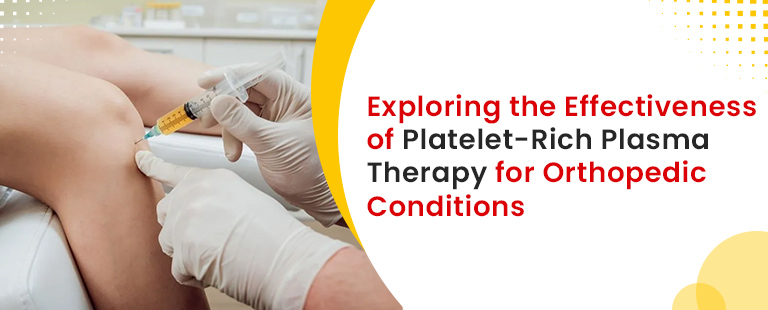Exploring the Effectiveness of Platelet-Rich Plasma Therapy for Orthopedic Conditions
Introduction
Platelet-rich plasma or PRP therapy is a new, advanced type of treatment that is changing the field of orthopedic medicine. PRP is a concentrated solution obtained from the patient’s own blood that contains a higher concentration of platelets compared to the concentration found in normal blood. Platelets play an important role in the natural healing process of the body by the release of growth factors that can help in stimulating tissue repair and regeneration.
PRP helps in orthopedics by promoting tissue healing, alleviating pain, and reducing inflammation. It helps in faster healing and has a much lower risk compared to other treatment methods.
In this article, we will be discussing in detail how PRP treatment can help people suffering from musculoskeletal or orthopedic problems.
How Does Platelet-Rich Plasma Therapy Work?
The platelets present in blood consist of proteins and growth factors. These elements help in stimulating healing, supporting the growth of the cells, and the formation of new tissues. The first response of the body to any soft tissue injury is delivering several platelets to the injury site to start the process of repairing.
PRP therapy is a type of regenerative medicine that takes advantage of the natural healing process of the body. The procedure involves the extraction and isolation of platelets and plasma from a sample of the patient’s own blood, which is then concentrated by the doctor into a healing solution. This solution is then injected back into the body by the doctor near the pain or injury area.
The growth factors then interact with the local cells and trigger them to heal the injury. This helps in tissue formation and a reduction in inflammation. The PRP solution can also act as a lubricating factor.
Common Orthopedic Conditions Treated by PRP Therapy
PRP therapy is beneficial to many athletes and active individuals suffering from orthopedic problems to recover rapidly and even avoid surgery in some cases. Research shows that PRP therapy has been successful in treating many orthopedic cases when conventional treatment methods like anti-inflammatory medications, cortisone injections, physiotherapy, and even surgery have failed to work.
PRP therapy may be used to treat the following different types of orthopedic conditions:
- Ligament injuries: Ligaments connect the bones to each other and are prone to tears and sprains. The regenerative properties of PRP therapy help contribute to improved healing and a decrease in recovery times.
- Tendon injuries: The tendons connect the muscles to bones and are prone to injuries like tendon tears and tendinitis, especially in people engaged in repetitive activities and athletes. The growth factors released in PRP therapy by the platelets help in the regeneration of the damaged tendon tissue.
- Muscle injuries: Muscle injuries like tears and strains can be treated using PRP therapy. Athletes are particularly benefited by the rapid healing provided by PRP injections so that they can resume their sporting activities sooner.
- Healing of fractures: Although PRP therapy is mainly used for soft tissue injuries, it is also known to help in the healing of fractures. Since PRP therapy helps in promoting new blood vessel formation and transferring the essential cells to the fracture site, PRP therapy can help in bone healing.
- Osteoarthritis: This is a degenerative joint disease that is characterized by cartilage breakdown. PRP injections given into the affected joint can help stimulate new cartilage production and reduce inflammation. Although osteoarthritis cannot be treated using PRP therapy, it offers relief from the symptoms associated with the condition and improves joint function.
- Spine conditions: Although research is still ongoing, some early studies state that PRP injections have an important role in disc regeneration and decreasing the pain associated with spinal conditions like disc degeneration.
Benefits of PRP Therapy in Orthopedic Treatment
PRP therapy has several advantages in the treatment of orthopedic conditions. The key advantages of PRP therapy are as follows:
- Rapid healing: PRP injections help in delivering concentrated growth factors to promote rapid healing and regeneration of tissue.
- Decreased recovery time: Since PRP therapy can improve tissue repair, it helps in reducing recovery time compared to conventional orthopedic treatments.
- Minimally-invasive procedure: Unlike surgical procedures, PRP therapy does not require any incisions or cuts and also decreases the risk of developing complications that are associated with invasive procedures.
- Autologous approach: Since the blood used in PRP therapy is that of the patient himself or herself a natural healing process takes place without the introduction of foreign bodies into the body.
- Reduced risk of allergy or infection: Since the PRP therapy is minimally invasive and makes use of the patient’s own blood, there is almost no risk of allergy or infection with it.
- Less cost: The cost of PRP therapy is much less compared to the cost of surgical interventions.
- Versatile: PRP therapy has shown to have promising results in various types of orthopedic conditions like muscle strains, ligament sprains, tendonitis, and osteoarthritis.
- Useful when surgery is contraindicated: Patients having comorbidities of patients who do not want to undergo surgery can opt for PRP therapy to treat their orthopedic condition.
Conclusion
PRP therapy has slowly emerged as an advanced tool that is effective in treating various orthopedic conditions, like tendon and ligament injuries, muscle injuries, osteoarthritis, spinal problems, and rapid healing of fractures. PRP therapy is a minimally-invasive procedure that offers several benefits like rapid and accelerated healing, lesser cost compared to surgery, reduced risk of complications, natural or autologous approach, and is a good treatment option for patients who cannot undergo surgery.
If you suffer from musculoskeletal problems, you can contact a good orthopedic surgeon to discuss your various treatment options and inquire if PRP therapy can help treat your condition.


